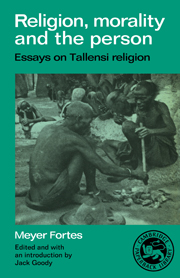Book contents
- Frontmatter
- Contents
- List of figures
- Introduction by Jack Goody
- 1 Divination: religious premisses and logical techniques
- 2 Prayer
- 3 Ritual festivals and the ancestors
- 4 Ancestor worship in Africa
- 5 Ritual and office
- 6 Totem and taboo
- 7 Coping with destiny
- 8 Custom and conscience
- 9 The first born
- 10 The concept of the person
- Endpiece: sacrifice among theologians and anthropologists
- Notes
- References
- Index
- Frontmatter
- Contents
- List of figures
- Introduction by Jack Goody
- 1 Divination: religious premisses and logical techniques
- 2 Prayer
- 3 Ritual festivals and the ancestors
- 4 Ancestor worship in Africa
- 5 Ritual and office
- 6 Totem and taboo
- 7 Coping with destiny
- 8 Custom and conscience
- 9 The first born
- 10 The concept of the person
- Endpiece: sacrifice among theologians and anthropologists
- Notes
- References
- Index
Summary
‘There can be no doubt at all’, says a famous authority on the subject, ‘that prayer is the heart and centre of all religion.’ In Tallensi religion, as among the Nuer, prayer is normally associated with sacrifice or libation, and it is this complex as a whole that is the centre of their ritual system. Tallensi religious beliefs and ritual practices presuppose personality analogous to that of humans in all the significant agents and powers of their supernatural domain. The dead (kpiinam) participate in the existence of the living (vopa) as identified ancestors, not in collective anonymity; the Earth (teη), the complementary pole of their mystical and moral universe, participates in the affairs of mankind in the form of personified, named, and particular sacred localities or shrines (toηbana). The religious system is pervaded by the personified representations of the ancestral dead and of the Earth. These draw all other agencies and objects and instrumentalities of ritual cult and action into their orbit. Medicines, for example, whether overtly magical or supposedly physical in action, are believed to be impotent without the concurrence of the ancestors and the Earth.
Given this system of beliefs and ideas, it is consistent for Tallensi ritual normally to include an interpersonal transaction between worshippers on one side and personalized mystical agencies on the other. Sacrifice and prayer are particularly apt media for such transactions and relations. The Tallensi have terms for both. The verb for ‘to sacrifice’ is ka‘;ab and it embraces every kind of ritual offering or libation at a consecrated place or altar.
- Type
- Chapter
- Information
- Religion, Morality and the PersonEssays on Tallensi Religion, pp. 22 - 36Publisher: Cambridge University PressPrint publication year: 1987
- 1
- Cited by



